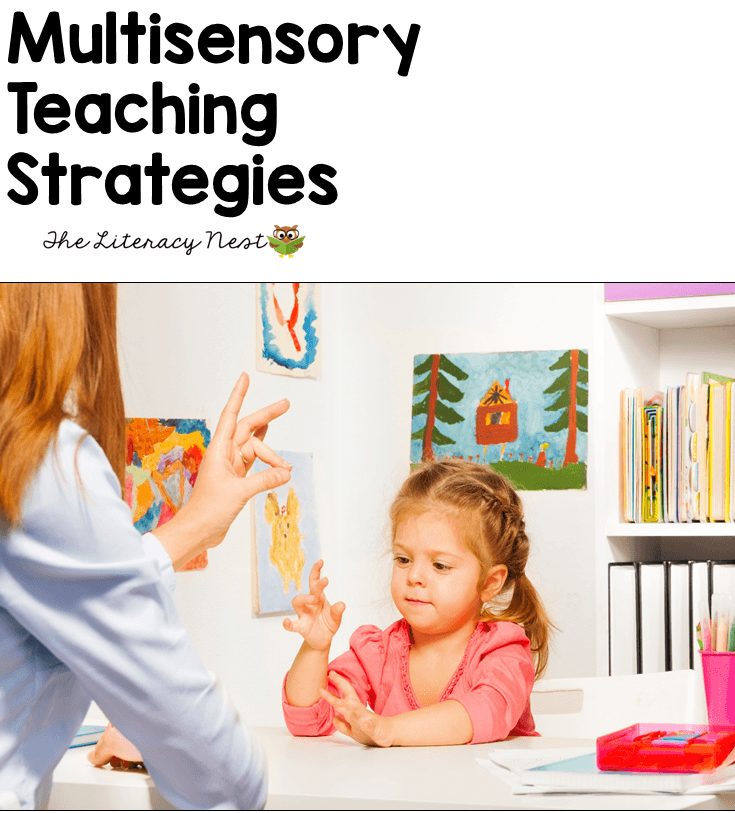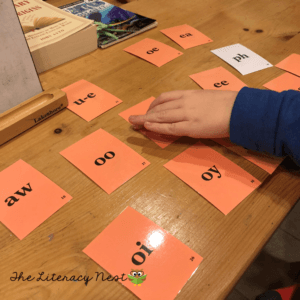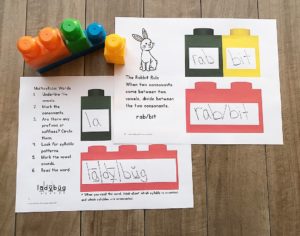Multisensory Teaching by Emily Gibbons

This post was written by Emily Gibbons, a dyslexia instructor. Emily provides suggestions for using multiple senses when teaching foundational reading skills.
Multisensory teaching is not just crucial for kids with dyslexia, it is good solid teaching for ALL students. Using a variety of senses helps with memory and retrieval and allows students to support their areas of weakness with their areas of strength. Incorporating multisensory learning tools into your classroom lessons will not replace intervention services, but it will make classroom lessons more accessible to students with learning differences.
What is multisensory teaching?
Multisensory teaching means that when information is presented, the learner is simultaneously using multiple senses. Visual, auditory and kinesthetic (or tactile) are the 3 primary senses that students use and these correspond to visual, auditory and motor (or muscle) memory.
The more pathways and connections a student uses for learning a new item of knowledge, the more pathways they have for retrieval of this information. Because so often children are asked to perform in school using what may be for them their weakest areas, linking these together can act as a bridge between a child’s strengths and weaknesses.
It is helpful to visualize the 3 senses (i.e., visual, auditory, kinesthetic/tactile) as part of a triangle. Try to use more than one corner of the triangle when possible. Even if you are only able to incorporate one additional modality, that is one additional pathway that you are creating for your students to access their learning.
Here’s a FREE language triangle freebie poster to display and explain multisensory teaching to your students!
Multisensory Instruction Suggestions for Beginning Reading Instruction
You may find that you are engaging in more multisensory learning tools than you realize or that current activities can become multisensory with a minor tweak. Many of these teaching practices are also suitable for classroom accommodations for struggling learners. Here are just some of the ways that you can incorporate multisensory teaching strategies into a foundational reading lesson:
- Use phonogram cards for sound symbol associations and blending.
Particularly in the lower grades, as sound symbol associations and blending are being introduced, the use of a phonogram and blending drill is good practice for all students. Using a keyword and picture provides extra support for those who need it. “12 Fresh Ideas for Phonogram Card Drills” may provide additional suggestions to engage your students.

- Practice teacher dictation where students say and write the responses.
Using dictation with simultaneous oral spelling (S.O.S.) is probably best accomplished in a small group setting such as a reading group, but could also be useful for whole group practice of spelling words or sight words. Dictation can be done at a word level or a sentence level. Students segment the sounds in a word using finger tapping, spell orally and spell as they write. Doing this as an instructional activity not only helps students learn the information, but also helps normalize the strategies when a student with disabilities needs to utilize them in a different setting. Read more about S.O.S. or simultaneous oral spelling here.
- Ask students to touch and say each word or each letter to read or check spelling.
This is an example of an activity that is not only suitable as an instructional activity, but also as a way of scaffolding striving readers and writers in the classroom. When a student is reading a difficult word, having them trace the letters as they say the sounds can be extremely helpful. Also, encouraging students to check their spelling by pointing and saying each letter helps students identify and correct common errors like forgotten letters or omitted words.
- Use magnetic letters for word study.
The use of magnetic letters for practicing a spelling rule, high frequency words, or spelling patterns incorporates a hands-on kinesthetic component to word study. Not only is this helpful for students who benefit from the use of the additional modality, it is also engaging and motivating for students.
- Highlight word parts or use diacritical marks for vowels, consonants and syllable division.
Marking up words is a great way for students to use their multiple senses practice the phonological concepts they have been taught. Highlighting and marking up words provides a visual support and also a kinesthetic experience.

- Tap out phonemes (Finger tapping and spelling).
Utilizing finger tapping, either finger to thumb or on the table, is a strategy that is not when introducing a new phonogram. By making this a strategy that everyone has been taught, students can use this as necessary without drawing unwanted attention.
- Sky or air write for spelling or handwriting.
When introducing new spelling words or giving direct instruction in letter formation, the use of sky writing incorporates gross muscle memory. Have students hold their arm out straight in front of them using two fingers as an imaginary pencil. Describe the movements for letter formation (straight line down, line across) or say the letters (S-A-I-D) as the students write the letters in the air in front of them. A straight arm, moving from the shoulder is the most effective way of using this strategy because it changes it from a fine motor to a gross motor activity.
- Use sand trays, rice trays, felt, playdough, sand paper letters, or other tactile surfaces.
Spelling or word work centers and handwriting are particularly well suited for tactile surface activities. Having students trace in or on different textures while saying the letter or sound out loud is a great way to incorporate a kinesthetic/tactile component and save trees! Some of my favorite tactile surfaces include seed bead trays, plastic canvas and velvet fabric. A great whole class tactile activity is to use shaving cream. Put a big squirt of inexpensive foaming shaving cream on each child’s desk or table area and practice writing letters, words, cursive and even math facts. A nice bonus is that shaving cream does not stain clothing or carpets. Be sure to allow a little extra time for drawing and playing. After about 30 minutes, the shaving cream has mostly evaporated. Simply wipe down the desks with a damp cloth. Not only does it provide some squishy fun practice, but it actually leaves desks sparkling clean.
- Use of whole body movements, whole arm movements and hand signals to prompt everything from handwriting and spelling to phonemes, vocabulary and concepts.
Getting a child’s whole body moving, whether they are hop scotching the syllables in a word or using a particular gesture to remember a tricky vowel sound is one of the best ways to solidify new learning. A bonus is that this kind of activity gets students who have difficulty attending engaged for longer periods of time.
- Have a listening center where students use audio text and follow along.
A listening center is great for struggling readers for several reasons. They are able to enjoy and experience stories that may not otherwise be accessible to them. They have a fluent model reading to help them develop a sense of what reading should sound like. While audiobooks alone are great, using the text to follow along is even better. Adding that visual component gets the ears and eyes working together and trains the eyes to move at a fluent speed through the text.
- Use visuals for reminders.
Many children with dyslexia also have some sort of memory challenges. Whether the issue is working memory or word retrieval, having visual prompts available either on bulletin boards or in a personal reference notebook is incredibly helpful for helping students access and utilize their knowledge.
- Use manipulatives to break apart sounds in words or syllables.
There is no end to creative ideas for ways to break apart sounds or syllables in words. Often, a classroom teacher need look no farther than the math manipulative shelf. Unifix cubes, colored counters, counting bears, links and more can all be useful. Masking tape or dry erase tape can allow you to add letters or words to the manipulatives. A student favorite is to pull in the occasional candy corn or M&M manipulative for special occasions.

- Use tracking tools like a finger, pointer, tongue depressor or bookmark.
Some teachers are firm believers that children should track with only their eyes as soon as possible. However, working with students with dyslexia has shown me that for students who are working so hard to orchestrate all the difference aspects of the reading task, using a finger to track can make the difference between accurate, smooth reading and reading that is full of errors. Even competent adult readers use a tracking finger when they are tired or reading something written in very small print or with complex technical language.
Conclusion
I hope that these suggestions for incorporating multisensory techniques into your lessons have inspired you and will be helpful to your students. Multisensory techniques of using visual, auditory and kinesthetic modalities together can be applied to skills of numeracy as well as reading and writing.
About Emily Gibbons
Emily is a Structured Literacy Dyslexia Instructor and an Associate Member of AOGPE. You may find her website at www.theliteracynest.com

 Joan Sedita is the founder of Keys to Literacy and author of the Keys to Literacy professional development programs. She is an experienced educator, nationally recognized speaker and teacher trainer. She has worked for over 35 years in the literacy education field and has presented to thousands of teachers and related professionals at schools, colleges, clinics, and professional conferences.
Joan Sedita is the founder of Keys to Literacy and author of the Keys to Literacy professional development programs. She is an experienced educator, nationally recognized speaker and teacher trainer. She has worked for over 35 years in the literacy education field and has presented to thousands of teachers and related professionals at schools, colleges, clinics, and professional conferences.
Leave a Reply